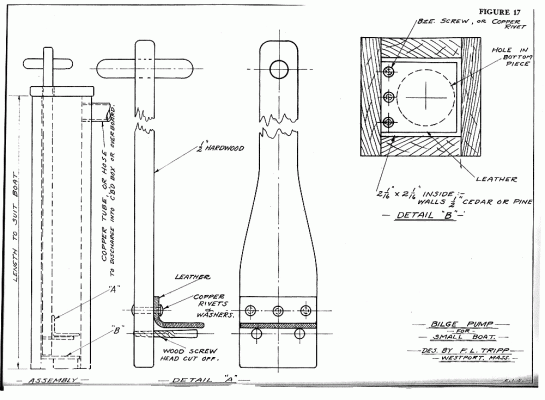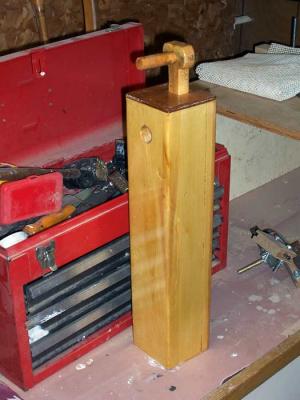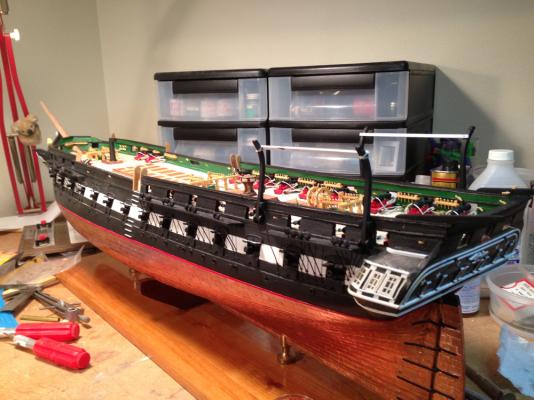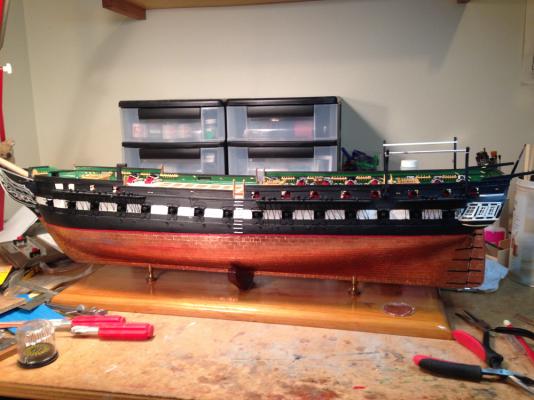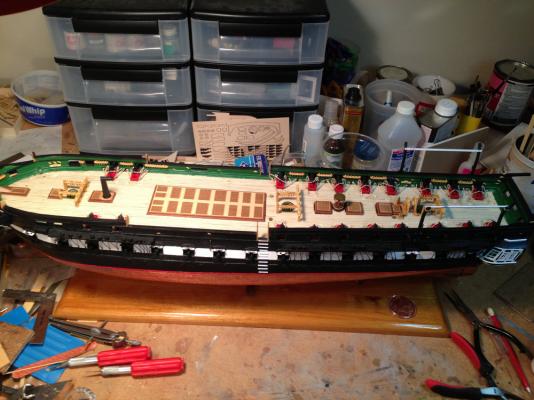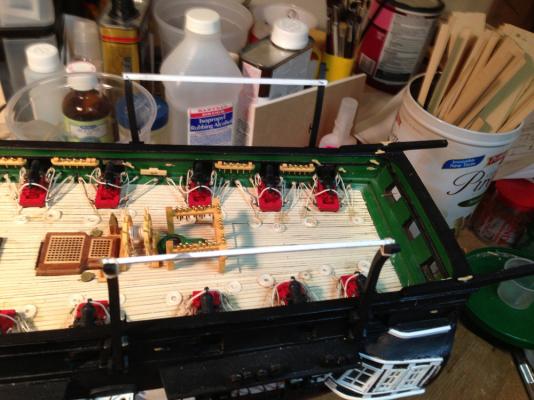-
Posts
727 -
Joined
-
Last visited
Content Type
Profiles
Forums
Gallery
Events
Everything posted by capnharv2
-
- 2,215 replies
-
Michael, You want to come down and work on the rigging on our boat? It's not much larger, and yours looks so much better. . . Thanks, Harvey
- 2,215 replies
-
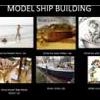
Freezer Paper - an awesome tool
capnharv2 replied to Mahuna's topic in Modeling tools and Workshop Equipment
I'll want to do more checking too Mike. What I recall as "Butcher's paper" is brown. I don't know, maybe I grew up in an alternate universe Harvey -

Freezer Paper - an awesome tool
capnharv2 replied to Mahuna's topic in Modeling tools and Workshop Equipment
Here's a dumb question-is Freezer paper the same a Wax paper? -
My first wooden kit (30 years ago) was a Golden Kits Schooner Enterprise. The scale was shown as 1:60 on the box and plans. Constructo now offers a Schooner Enterprise. The scale is shown as 1:51. I've looked at build logs here for the Constructo Enterprise, and it looks like the same Golden Kits Enterprise I built, but the scales are different. So my question is-are they the same size kit with the scale changed on box and plans, or are they 2 different kits? And, if they are the same, what scale is it? Thanks, Harvey
-
Hi Bob, I'm glad you likes the pictures. The steaming of the cabintop side (1" x 15" x 20 feet) was a real challenge as well as fun and educational. Since those photos, we recaulked the seams and replaced 250 fasteners in the bottom. She went from leaking like a sieve to not taking on any water since the day we put her in. One more thing about a wooden boat. The worst thing you can do to a wooden boat is seal her up and not use her. We've seen a lot of nice boats turn into piles of rot that way. I don't have a good answer about historic bilge pumps. The best I've found so far are some examples of wooden manual pumps used in the 20's and 30's. I'll be away for a week or so, but I'll do some more checking when I get back. A couple other places to check would be the Maine Maritime Museum, the Penebscot Marine Museum and Mystic Seaport. No guarantees, but they are good sources (and fun places to visit if you can!). Hope that helps. Thanks, Harvey
- 86 replies
-
- muscongus bay lobster smack
- Midwest Products
-
(and 1 more)
Tagged with:
-
Russ, I apologize-I was wrong about it being AOTS. The book is "The Hudson's Bay Company's 1835 Steam Ship Beaver" by John McKay (published by Vanwell Publishing Ltd. (April 2004). The book's layout is very similar to AOTS and has several plates describing the build and, mostly, the steam engine. I don't have the book anymore (I borrowed it from a museum), but the information on ordinance was almost non-existent. McKay references a couple sources, but I haven't checked them out yet. I probably will when I'm back in town. But if you have some sources for merchant vessel ordinance from that period that would be very helpful. Thanks, Harvey
-
While we're on the subject. . . I've been asked to build cannon for a model of the Hudson Bay Co. Steamship Beaver, launched in 1835. So far, I've been unable to find much about cannon from that era. AOTS Beaver lists 5-Nine pounders, but says they were probably short cannon, and have no pictures to base anything on. I tried using Hahn's formulas, but the lengths came out too long to use on the ship. Also, since it was a merchant ship, not a naval vessel, that further clouds things (to me). If anybody can help figure this out I'd appreciate it Thanks! Harvey
-
Hexnut, Ask away! I don't know all that much, but I've loved Friendship Sloops since I first laid eyes on them. I've tried to find out as much about them and the Muscongus Bay Lobster smacks as possible. But there's always more to learn. I still have my old blog up http://www.bearsafloat.net/capnharv/ I haven't updated it in years, but it does have some of our pictures of rebuilding our boat's cabin top on it. And it's got a few more ship models. Who knows, I may start updating it again. Thanks for posting pictures your fine work. It's certainly an inspiration to me. Harvey
- 86 replies
-
- muscongus bay lobster smack
- Midwest Products
-
(and 1 more)
Tagged with:
-
Mark, It really looks good! I admire the fact that the first 3 versions were probably good enough, but that you wanted to do better. I think of re-planking exercises like this as a learning experience for our next model(s). But I also realize that the more we learn, the more we learn that there's so much more to learn. Thanks, Harvey
-
Wonderful Bob! You're doing what I've always wanted to do, and doing an excellent job! With a little luck, I will do the same one day Thanks, Harvey
- 86 replies
-
- muscongus bay lobster smack
- Midwest Products
-
(and 1 more)
Tagged with:
-
Slowly but surely (or is it surly?) Davits and Cleats are on. Rudder is on, but spectacle plate and chains need to be added. And the bow cleats and Charlie Noble are in place All the big pieces are on. About the only things left are the 2 cannon, anchors, steps, a few iron cleats and deck eyebolts for rigging. The hammock cranes and small boats need to be done, but I can work on them later. I hope to start masts and rigging in a couple months. Thanks, Harvey
-
I concur with Greg. I bought a couple sets of #70-#79 bits last month and I'm very happy with them. Harvey
-
Really nice! Harvey
- 89 replies
-
- muscongus bay lobster smack
- midwest products
-
(and 1 more)
Tagged with:
-
Bob, That looks like lots of fun! I wish I had time to build some of these models. It looks like a Malabar Jr to me too. There are plans for it in "Fifty Wooden Boats: A Catalog of Building Plans, Vol.1" The same book has plans for Alden's Malabar 2 Schooner (42'). That's another one I'd like to build one day. Thanks! I'm going to enjoy this build! Harvey
-
Peter, I see some problems using plywood for planking. First off, it doesn't like to bend and twist. Second, sealing the edges can be a problem (I know you're going to paint, but those open edges will suck up a lot of paint. Third, I don't know what the adhesive is in the plywood, but it could dissolve by using the wrong chemicals. That said, there are quite a few full size plywood boats out there. The row and sail boats from Arch Davis come to mind. Sam Devlin (in Olympia, WA) has also made many outstanding plywood boats. So it can be done. It's just that, at the scales we build to, the working issues with plywood (other than for keels and bulkheads) seem to get magnified. A different solution might be to plank over the balsa with basswood strips or cover the balsa with gesso and scribe the plank lines into that. Anyway, I hope that helps. Thanks, Harvey
- 89 replies
-
- muscongus bay lobster smack
- midwest products
-
(and 1 more)
Tagged with:
-
I think you're correct. Unfortunately, the understanding of fabric (either natural or synthetic), its design, construction and coloration is not my forte. I have "The Sailmaker's Apprentice" by Marino, but I haven't dug into it much. Maybe after I learn to sail and learn to build ship models Thanks, Harvey
-
Weflack, Our boat has tanbark sails: One interesting thing about tanbark. On cotton sails, it was used to extend the life of sails. On Dacron sails, Tanbark sails are more UV sensitive than white dacron sails, and tend to fade and degrade faster Thanks, Harvey
About us
Modelshipworld - Advancing Ship Modeling through Research
SSL Secured
Your security is important for us so this Website is SSL-Secured
NRG Mailing Address
Nautical Research Guild
237 South Lincoln Street
Westmont IL, 60559-1917
Model Ship World ® and the MSW logo are Registered Trademarks, and belong to the Nautical Research Guild (United States Patent and Trademark Office: No. 6,929,264 & No. 6,929,274, registered Dec. 20, 2022)
Helpful Links
About the NRG
If you enjoy building ship models that are historically accurate as well as beautiful, then The Nautical Research Guild (NRG) is just right for you.
The Guild is a non-profit educational organization whose mission is to “Advance Ship Modeling Through Research”. We provide support to our members in their efforts to raise the quality of their model ships.
The Nautical Research Guild has published our world-renowned quarterly magazine, The Nautical Research Journal, since 1955. The pages of the Journal are full of articles by accomplished ship modelers who show you how they create those exquisite details on their models, and by maritime historians who show you the correct details to build. The Journal is available in both print and digital editions. Go to the NRG web site (www.thenrg.org) to download a complimentary digital copy of the Journal. The NRG also publishes plan sets, books and compilations of back issues of the Journal and the former Ships in Scale and Model Ship Builder magazines.




